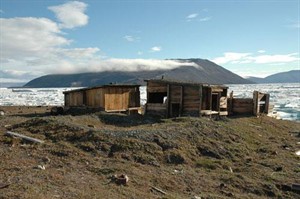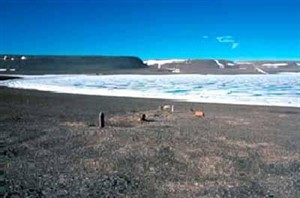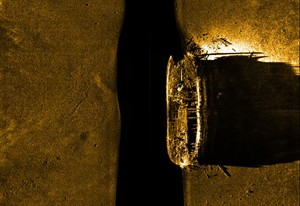Frozen in Time: Exploration in Canada’s Arctic
Canada is a northern nation with a vast polar region that has
held an important place in our imaginations for some time. The
Arctic is a unique landscape, with terrain and phenomena that are
found only in this distinct climate. Trees do not grow north of the
Arctic Circle and the environment is like no other, producing bone
chilling temperatures for a significant portion of the year. The
Arctic is also witness to the polar night, a 24 hour state of
darkness, and the midnight sun, the opposite phenomena.
The determination to explore the Arctic stemmed from a desire
for expansion, discovery and research. Expeditions desperately
wanted to chart new routes for trade and to claim sovereignty over
newly discovered lands. Once land had been claimed, investigation
turned to research and the study of the culture and practices of
the local Inuit.
Nineteenth century Arctic exploration in Canada has a rich and
tumultuous history that is filled with grand successes but also
dismal failures. Victories came in the shape of momentous new
discoveries, such as charting new islands and passages, but
failures cost crews not only their dreams of discovery but often
their lives. A variety of historic places designations remind us of
this history of Canadian northern exploration in the late
nineteenth and early twentieth century. A century later Canadians
can look back on these historic expeditions, fearless explorers,
and the remains of early exploration sites and remember the
triumphs and pitfalls of human encounters with Canada's far
North.
 The rich history of Arctic exploration
is evident at Fort
Conger (left), located on the northeast coast of
Ellesmere Island in Nunavut. Fort Conger is comprised of three huts
built in 1900 by Robert E. Peary to better enable his success in
reaching the North Pole. However, the history of Fort Conger
predates Peary's use. The site was a great asset to arctic
expeditions and was first used in 1881 by British Captain George S.
Nares, and, seven years later, by American Lieutenant Adolphus
Greely. These missions both ended tragically due to poor shelter
and lack of supplies. Peary's voyage almost experienced the same
fate when his ship, the Windward, which he had planned to
live in, did not arrive as expected at Fort Conger. Peary cunningly
devised plans to build his own insulated shelter combining his
knowledge of Arctic building techniques with western materials and
leftover supplies from the Greely journey. While Peary's 1901-02
mission was not successful, he returned in 1909 and once again used
Fort Conger as a base, this time reaching the North Pole. Over a
century old, Peary's structures remain as a testament to this
achievement.
The rich history of Arctic exploration
is evident at Fort
Conger (left), located on the northeast coast of
Ellesmere Island in Nunavut. Fort Conger is comprised of three huts
built in 1900 by Robert E. Peary to better enable his success in
reaching the North Pole. However, the history of Fort Conger
predates Peary's use. The site was a great asset to arctic
expeditions and was first used in 1881 by British Captain George S.
Nares, and, seven years later, by American Lieutenant Adolphus
Greely. These missions both ended tragically due to poor shelter
and lack of supplies. Peary's voyage almost experienced the same
fate when his ship, the Windward, which he had planned to
live in, did not arrive as expected at Fort Conger. Peary cunningly
devised plans to build his own insulated shelter combining his
knowledge of Arctic building techniques with western materials and
leftover supplies from the Greely journey. While Peary's 1901-02
mission was not successful, he returned in 1909 and once again used
Fort Conger as a base, this time reaching the North Pole. Over a
century old, Peary's structures remain as a testament to this
achievement.
 The Beechy Island
National Historic Site of Canada (right) tells the story of an
arctic expedition gone awry and the countless search attempts that
followed. Sir John Franklin's 1845-46 voyage was the
first to use Beechy Island as a wintering site in their pursuit of
the northwest passage and during their exploration of the polar
region. One of their objectives was to demystify the arctic by
performing a variety of zoological, botanical, magnetic, and
geological surveys, and by charting a reliable route from Europe to
the Orient. This voyage was short lived, however, as their ships
soon became icebound near King William Island. Franklin's
expedition reached a tragic end: all of the crewmembers of HMS
Erebus and HMS Terror died and very few traces
of the expedition remained. With no word from the mission, concern
mounted in England and many search parties followed. Although
little was found of Franklin or his men, these early rescue efforts
led to the mapping of a large part of the Canadian Arctic and the
discovery of three northwest passages.
The Beechy Island
National Historic Site of Canada (right) tells the story of an
arctic expedition gone awry and the countless search attempts that
followed. Sir John Franklin's 1845-46 voyage was the
first to use Beechy Island as a wintering site in their pursuit of
the northwest passage and during their exploration of the polar
region. One of their objectives was to demystify the arctic by
performing a variety of zoological, botanical, magnetic, and
geological surveys, and by charting a reliable route from Europe to
the Orient. This voyage was short lived, however, as their ships
soon became icebound near King William Island. Franklin's
expedition reached a tragic end: all of the crewmembers of HMS
Erebus and HMS Terror died and very few traces
of the expedition remained. With no word from the mission, concern
mounted in England and many search parties followed. Although
little was found of Franklin or his men, these early rescue efforts
led to the mapping of a large part of the Canadian Arctic and the
discovery of three northwest passages.
2013 marked the 100th anniversary of the 1913-1918 Canadian Arctic Expedition National
Historic Event. The mission was of great significance in
our nation's history because it was the first voyage to the western
arctic to be funded by the federal government, and it was one of
the biggest scientific arctic expeditions ever launched. Fraught
with hardships for the crew and their vessels, the mission
continued to push forward and in the end was deemed a great
success. Vilhjálmur Stefánsson led the expedition
in the hopes of obtaining new Arctic lands for Canada and beginning
new scientific research. During the first year hopes of great
discoveries were replaced by the need to learn how to survive in
this harsh climate. The fate of the unlucky was often starvation
and death: 12 crew members were lost in the first year.
It soon became clear that the survival of the crew would require
the wisdom of the Inuit. Teams of dogs were taught to hunt and
navigate the icy terrain, and knowledgeable Inuit lent their vast
skills to the expedition as both hunters and crew members. Despite
all of the roadblocks the Canadian Arctic Expedition only grew
stronger, and this unwavering determination led to its great
success. The scientists returned with thousands of animal, plant,
fossil and mineral samples as well as artefacts from the Inuit
culture that provided great opportunities for further research.
Stefánsson himself discovered the remaining major arctic islands,
another successful aspect of the mission.
 To this day stories of
exploration in the polar region continue to fascinate the world and
to motivate further exploration. Until recently, the Erebus
and Terror National Historic Site of Canada (left) commemorated
the two ships that were lost during Franklin's failed attempt to
cross the arctic in 1845. However in September 2014 Parks Canada's team located HMS Erebus,
achieving a great, contemporary arctic discovery. Underwater
archaeologists are at work exploring this fantastic find, and the
search continues for HMS Terror.
To this day stories of
exploration in the polar region continue to fascinate the world and
to motivate further exploration. Until recently, the Erebus
and Terror National Historic Site of Canada (left) commemorated
the two ships that were lost during Franklin's failed attempt to
cross the arctic in 1845. However in September 2014 Parks Canada's team located HMS Erebus,
achieving a great, contemporary arctic discovery. Underwater
archaeologists are at work exploring this fantastic find, and the
search continues for HMS Terror.
Designations such as Fort Conger, Beechy Island, the 1913-1918
Canadian Arctic Expedition, Vilhjálmur Stefánsson and Erebus and
Terror National Historic Site of Canada help to tell the gripping
story of Arctic exploration and discovery in Canada. Although not
always a smooth ride, tragedy was often turned into triumph and
disaster into success. Misfortune led to the discovery of three new
northwest passages and adversity led to scientific
breakthroughs.
These triumphs would not have been possible without the guidance
of the Inuit who taught the explorers to survive in the harsh
Arctic conditions, and who even offered to join the expeditions as
hunters and crew members. This partnership between the Inuit and
the European explorers facilitated the many successes achieved in
northern exploration.
As a strong Northern country, Canada feels a unique pull towards
Arctic exploration. There is great pride in this Northern
landscape, in its cultural heritage, and in all the treasures that
lie within it. Now a century after the Canadian Arctic Expedition,
it is important to remember not only the accomplishments, but also
the obstacles that led to Canada's contribution in mapping the
Arctic.